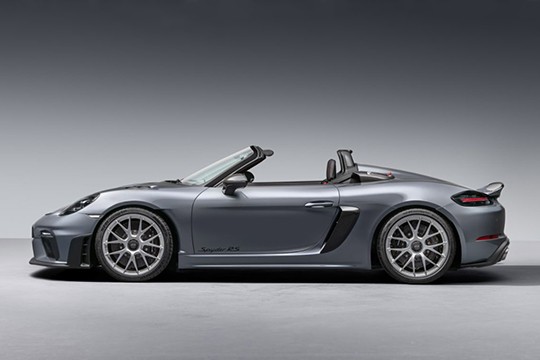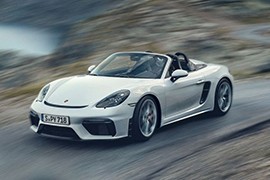PORSCHE 718 Spyder Models/Series Timeline, Specifications & Photos
First production year: 2019
Engines: Gasoline
Body style: Convertible (spider/spyder, cabrio/cabriolet, drop/open/soft top)
In 2023 Porsche unveiled the Spyder version of the 718 Cayman GT4 RS, but somehow it managed to save some weight compared to the fixed-roof version in the process.
The German automaker used to have unusual open-top vehicles, such as the 911 Speedster or the 2009 Boxster Spyder. It built these sports cars to be driven under the open sky and only covered only when needed. They were not just like regular convertibles that people drove with the top up and AC on during hot summer days. So, Porsche continued the same idea when it developed the 718 Cayman Spyder RS.
Porsche went the whole nine yards to create a real race car able to wear license plates. Thus, since the car no longer had a fixed roof, it had to find other solutions to create a zero-lift aerodynamic vehicle, and the engineers did it. At the front was a new spoiler that included a wider chin to increase downforce. Furthermore, the carbon fiber front fenders sported redesigned vents that extracted air from wheel wells, reducing the lift. A surprising decision was to make the windscreen's frame slimmer, at least at the top, since it was also a safety arch. On the car's sides, the automaker placed a pair of air intakes on the quarter panels. Finally, at the back, a wide duck-tail that resembled the one installed on the glorious Porsche 935 "Moby Dick" added more downforce to the vehicle.
The interior looked very with the same race bucket seats as in the 718 Cayman GT4 RS, but available with either red or gray inserts. The roof was stored behind the cabin in a special compartment and was manual. No electronic was involved. Porsche did that to save weight. While the roof didn't provide too much protection against rain, it was more effective than an umbrella and a baseball cap.
As expected, Porsche installed the same flat-six powerplant found in the 718 Cayman GT4 RS and the GT3 Cup race car. It was a 9,000 rpm, 4.0-liter engine that produced 500 PS (493 hp) sent to the rear wheels via a standard seven-speed automatic (dual-clutch) PDK gearbox.
When Porsche introduced the Boxster/Cayman duo on the market, its customers were outraged, even though those two models greatly helped the brand's finances, and over time, these vehicles attracted more buyers for the German sportscar brand.
Fast forward to 2019, and Porsche introduced the topless version of the 718 Cayman GT4, namely the 718 Spyder. The German automaker tried to provide customers with an engaging supercar concealed under the skin of a sportscar. It was mostly an analog vehicle fitted with a six-speed manual and even a manual roof cover. The driver had to stop the vehicle in order to cover or uncover the two-seat cabin, which looked odd, but it was a solution to save weight. Essentially, the 718 Spyder was the ultimate driver's car made by Porsche.
The car's look left no room for errors in terms of guessing the brand. Its headlights, which featured four LED blocks inside, resembled those installed in the 911, the Panamera, or the Cayenne. The flat and low nose suggested that there was no engine underneath, just a frunk to hold some stuff, but not too much. A massive A-shaped lower grille covered the apron and was flanked by a set of side scoops that cooled the front rotors. From its profile, the 718 Spyder revealed the big side intakes in front of the enlarged rear fenders, and when uncovered, there was nothing to hold back air between the A-pillars and the bulges and safety arches behind the car's occupants' seats. The long rear deck covered not just the engine but also an additional trunk mounted between the powerplant and the rear bumper, in addition to the one mounted up front, under the hood.
Inside, Porsche created a sporty cabin with high-bolstered seats separated by a tall center console that housed the gear stick and the buttons for the traction control system, the suspension settings, the rear wing deployment, the active exhaust system, and the start-stop function. The high bolstered bucket seats held their occupants firmly in place during high-speed cornering maneuvers and were very comfortable on long roads. Fronting the driver was an instrument cluster where the rev counter took center place and was flanked by the speedometer on the left and a round LCD on the right that showed data from the car's onboard computer, such as the accelerometer (G-meter) or the fuel level.
Behind the cabin, in a mid-mounted position, Porsche installed a naturally aspirated flat-six engine that produced 420 PS (414 hp) paired with a six-speed manual that sent all the oomph to the rear wheels only. Despite not being the most performance car in the carmaker's lineup, the 718 Spyder was a true Porsche thanks to its road holding and the feedback offered to the driver.

